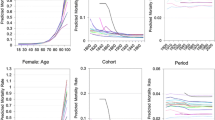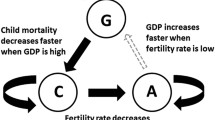Abstract
Analyzing a variety of cross-national and sub-national data, we argue that high adult mortality reduces economic growth by shortening time horizons. Paying careful attention to the age pattern of mortality and to endogeneity issues, we find that a greater risk of death during the prime productive years is associated with higher levels of risky behavior, higher fertility, and lower investment in physical capital, even when controlling for infant mortality. In our regressions, adult mortality explains almost all of Africa’s growth tragedy. This analysis underscores grim forecasts of the long-run economic costs of the ongoing AIDS epidemic.
Similar content being viewed by others
References
Acemoglu D., Johnson S. (2005). Unbundling institutions. Journal of Political Economy 113(5): 949–995
Acemoglu, D., & Johnson, S. (2006). Disease and development: The effect of life expectancy on economic growth. NBER Working Paper #12269.
Acemoglu D., Johnson S., Robinson J.A. (2001). The colonial origins of comparative development: An empirical investigation. American Economic Review 91(5): 1369–1401
Alesina A., Spolaore E., Wacziarg R. (2000). Economic integration and political disintegration. American Economic Review 90(5): 1276–1296
Azarnert L. (2006). Child mortality, fertility and human capital accumulation. Journal of Population Economics 19(2): 285–297
Barro R. (1997). Determinants of economic growth. Cambridge, MIT Press
Barro, R. J., Lee, J.-W. (2000). International data on educational attainment: Updates and implications. Harvard CID Working Paper no. 42, April.
Barro, R. J., & Sala-i-Martin, X. (1996). Economic growth. Cambridge: MIT Press.
Becker, G. (1960). An economic analysis of fertility. In A. J. Coale (Ed.), Demographic and economic change in developed countries. Princeton, NJ: Princeton University Press, pp. 209–231.
Becker, G. S., Philipson, T. J., & Soares, R. R. (2005). The quantity and quality of life and the evolution of world inequality. American Economic Review, 95(1), 277–291.
Bell, F. C., & Miller, M. L. (2002). Life tables for the United States social security area 1900–2100. Actuarial Study No. 116. Downloaded from the Human Mortality Database, http://www.mortality.org. Accessed 1 Mar 2008.
Benhabib J., Spiegel M. (1994). The role of human capital in economic development: Evidence from aggregate cross-country data. Journal of Monetary Economics 34: 143–173
Ben-Porath Y. (1967). The production of human capital and the life cycle of earnings. Journal of Political Economy 75(4): 352–365
Bils M., Klenow P. (2000). Does schooling cause growth?. American Economic Review 90(5): 1160–1183
Bloom D.E., Canning D., Sevilla J. (2003). The demographic dividend: A new perspective on the economic consequences of population change. Santa Monica CA, Rand
Bloom D.E., Canning D., Sevilla J. (2004). The effect of health on economic growth: A production function approach. World Development 32(1): 1–13
Bos, E., Vu, M. T., & Stephens, P. W. (1992). Sources of world bank estimates of current mortality rates. Policy Research Working Paper 851, The World Bank, Washington, D.C.
Census of India: Registrar General and Census Commissioner (1961, 1971, 1981, 1991). Census of India, Government of India. http://www.censusindia.net.. Accessed 1 Mar 2008.
Central Intelligence Agency. (2004). The CIA world factbook 2004. Washington, DC: CIA. http://www.odci.gov/cia/publications/factbook/index.html. Accessed 1 Mar 2008.
Cervellati M., Sunde U. (2005). Human capital formation, life expectancy, and the process of development. American Economic Review 95(5): 1653–1672
Chakraborty S. (2004). Endogenous lifetime and economic growth. Journal of Economic Theory 116(1): 119–137
Chakraborty, S., Papageorgiou, C., & Perez-Sebastian, F. (2007). Diseases and development. Department of Economics, Louisiana State University, Departmental Working Papers.
Collier P., Gunning J.W. (1999). Explaining African economic performance. Journal of Economic Literature 37: 64–111
Deaton A. (2004). Health in an age of globalization. In: Collins S., Graham C., (eds) Brookings trade forum. Washington DC, The Brookings Institution
Doepke M. (2005). Child mortality and fertility decline: Does the Barro-Becker model fit the facts?. Journal of Population Economics 18(2): 337–366
Easterly W., Levine R. (1997). Africa’s growth tragedy: Policies and ethnic divisions. Quarterly Journal of Economics 112(4): 1203–1250
Ehrlich L., Lui F.T. (1991). Intergenerational trade, longevity, and economic growth. Journal of Political Economy 99: 1029–1059
Frankel J.A., Romer D. (1999). Does trade cause growth?. American Economic Review 89(3): 379–399
Freedom House. (2004). Freedom in the world 2004, The annual survey of political rights and civil liberties. Washington, DC: Freedom House. http://www.freedomhouse.org/ratings/index.ht.. Accessed 1 Mar 2008.
Gallup, J. L., Mellinger, A. D., & Sachs, J. D. (2001). Geography datasets. http://www.cid.harvard.edu/ciddata/geographydata.ht.. Accessed 1 Mar 2008.
Galor O. (2005). The demographic transition and the emergence of sustained economic growth. Journal of European Economic Association 3(3): 494–504
Galor, O., & Moav, O. (2007). The neolithic origins of contemporary variations in life expectancy. working paper, Brown University, November.
Galor O., Weil D. (1999). From Malthusian stagnation to modern growth. American Economic Review 89(2): 150–154
Ghosh B., Marjit S., Neogi C. (1998). Economic growth and regional divergence in India, 1960 to 1995. Economic and Political Weekly 33(26): 1623–1630
Hauk, W. R., Jr., & Wacziarg, R. (2004). A Monte Carlo study of growth regressions. NBER Technical Working Paper #296.
Heston, A., Summers, R., Aten, B. (2002). Penn world table version 6.1. Center for International Comparisons at the University of Pennsylvania (CICUP), October. http://pwt.econ.upenn.edu.. Accessed 1 Mar 2008.
Hill, K. (2003). Adult mortality in the developing world: What we know and how we know it. presented at the United Nations Training Workshop on HIV/AIDS and Adult Mortality in Developing Countries.
Kalemli-Ozcan S. (2002). Does the mortality decline promote economic growth?. Journal of Economic Growth 7(4): 411–439
Kalemli-Ozcan S. (2003). A stochastic model of mortality, fertility, and human capital investment. Journal of Development Economics 70(1): 103–118
Kalemli-Ozcan, S. (2007). AIDS, reversal of the demographic transition and economic development: Evidence from Africa. working paper, University of Houston.
Kalemli-Ozcan S., Ryder H.E., Weil D.N. (2000). Mortality decline, human capital investment, and economic growth. Journal of Development Economics 62(1): 1–23
Lacina B., Gleditsch N.P. (2005). Monitoring trends in global combat: A new dataset of battle deaths. European Journal of Population 21(2–3): 145–166
Lobitz B., Beck L., Huq A., Wood B., Fuchs G., Faruque A.S.G., Colwell R. (2000). Climate and infectious disease: Use of remote sensing for detection of Vibrio cholerae by indirect measurement. Proceedings of the National Academy of Sciences 97(4): 1438–1443
Lorentzen, P., McMillan, J., & Wacziarg, R. (2005). Death and development. NBER Working Paper #11620, September.
Mackay, J., & Eriksen, M. (2002). The tobacco atlas. World Health Organization, Geneva (Switzerland).
Mankiw N.G., Romer D., Weil D.N. (1992). A contribution to the empirics of economic growth. Quarterly Journal of Economics 107(2): 407–437
Masters W.A., McMillan M.S. (2001). Climate and scale in economic growth. Journal of Economic Growth 6(3): 167–186
Murray, C. J. L., Ahmad, O. B., Lopez, A. D., & Salomon, J. A. (2000). WHO system of model life tables. Global Programme on Evidence for Health Policy Discussion Paper Series: No. 8. World Health Organization.
National Research Council. (2001). Under the weather: Climate, ecosystems, and infectious disease. Division on Earth and Life Sciences, Board on Atmospheric Sciences and Climate, Committee on Climate, Ecosystems, Infectious Disease and Human Health, Washington, DC: National academy Press.
Pritchett L. (2001). Where has all the education gone?. World Bank Economic Review 15(3): 367–391
Reserve Bank of India (various years), Report on currency and finance, Volume II. Statistical statements. Mumbai: M/S Vijay Corporation.
Sachs J., Kiszewski A., Mellinger A., Spielman A., Malaney P., Ehrlich S. (2004). A global index of the stability of malaria transmission. American Journal of Tropical Medicine and Hygiene 70(5): 486–498
Soares R.R. (2005). Mortality reductions, educational attainment, and fertility choice. American Economic Review 95(3): 580–601
Staiger D., Stock J.H. (1997). Instrumental variables regression with weak instruments. Econometrica, 65(3): 557–586
Stock J.H., Wright J.H., Yogo M. (2002). A survey of weak instruments and weak identification in generalized method of moments. Journal of Business and Economic Statistics 20(4): 518–529
Tavares J., Wacziarg R. (2001). How democracy affects growth. European Economic Review 45(8): 1341–1378
UNAIDS: Joint United Nations Program on HIV and AIDS. (2004). 2004 report on the global AIDS epidemic: 4th global report. Geneva: UNAIDS. http://www.unaids.org/en.. Accessed 1 Mar 2008.
Wacziarg R. (2001). Measuring the dynamic gains from trade. World Bank Economic Review 15(3): 393–429
Weil D.N. (2007). Accounting for the effect of health on economic growth. Quarterly Journal of Economics 122(3): 1265–1306
World Bank. (2004). World development indicators 2004. Washington, DC: The World Bank, http://publications.worldbank.org/WDI.. Accessed 1 Mar 2008.
World Health Organisation. (2005). Chernobyl: The true scale of the accident. http://www.who.int/mediacentre/news/releases/2005/pr38/en/index1.htm.. Accessed 1 Mar 2008.
Young A. (2005). The gift of the dying: The tragedy of AIDS and the welfare of future African generations. Quarterly Journal of Economics 120(2): 423–466
Author information
Authors and Affiliations
Corresponding author
Additional information
Most of the work for this paper was completed prior to the tragic passing away of our dear friend and colleague John McMillan in March of 2007.
Rights and permissions
About this article
Cite this article
Lorentzen, P., McMillan, J. & Wacziarg, R. Death and development. J Econ Growth 13, 81–124 (2008). https://doi.org/10.1007/s10887-008-9029-3
Published:
Issue Date:
DOI: https://doi.org/10.1007/s10887-008-9029-3




